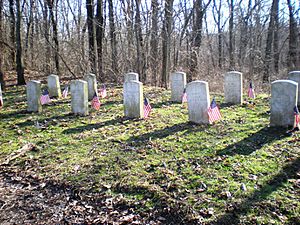Battle of the Mississinewa facts for kids
Quick facts for kids Battle of the Mississinewa |
|||||||
|---|---|---|---|---|---|---|---|
| Part of the War of 1812 | |||||||
|
|||||||
| Belligerents | |||||||
| Miami tribe | |||||||
| Commanders and leaders | |||||||
| Francis Godfroy Joseph Richardville |
John B. Campbell | ||||||
| Strength | |||||||
| 300 infantry | 600 cavalry | ||||||
| Casualties and losses | |||||||
| 38 killed (claimed) 8 men and 34 others captured |
12 killed 46 wounded |
||||||
The Battle of the Mississinewa was an important event during the War of 1812. It happened in December 1812 near what is now Marion, Indiana. This battle was a military mission ordered by William Henry Harrison to stop attacks by the Miami tribe on American forts like Fort Wayne and Fort Harrison.
Today, the battle site hosts a big yearly event called Mississinewa 1812. It's the largest reenactment of the War of 1812 in the United States. Thousands of visitors come to this festival every October. In 2004, a large memorial was put up near the Mississinewa River in downtown Marion to remember the battle.
The Expedition Begins
After getting permission from the Secretary of War, William Henry Harrison ordered an expedition. Lieutenant Colonel John B. Campbell was chosen to lead it. His main goal was to destroy Miami villages along the Mississinewa River.
Campbell's force had 600 mounted soldiers, meaning they rode horses. They left Fort Greenville on December 14, 1812. After traveling about 80 miles (130 km), they reached a village on December 17. They took 42 prisoners from the Lenape tribe there.
Attacks and Counterattacks
The soldiers then moved along the Mississinewa River. They attacked at least two Miami villages. The Miami people were surprised and had not left their homes. Many Miami were killed, and 76 were taken prisoner. This group included 34 women and children.
Later that day, Campbell thought about returning to Fort Greenville. Many of his soldiers were suffering from severe frostbite.
The next morning, December 18, a large group of Native American warriors fought back. They attacked Campbell's troops as they returned to the first village. Even though they were outnumbered, the Native Americans fought hard. They wanted to rescue the villagers who had been captured.
American cavalry (soldiers on horseback) charged, led by Major James McDowell and Captains Trotter and Johnston. This charge finally broke the attack.
After the Battle
The American forces lost 8 soldiers killed and 48 wounded. Four of the wounded later died. Campbell claimed that 8 Native Americans were killed on December 17. He also said at least 30 were killed on December 18. In total, 8 warriors and 34 women and children were captured.
One of the captured villagers told Campbell that Tecumseh was nearby. Tecumseh was a famous Native American leader. He was supposedly coming with hundreds of men. Because of this news, Campbell decided to march back to Fort Greenville. He took the 42 prisoners with him.
The journey back was very difficult. Many American soldiers suffered badly from frostbite. By the time they reached Fort Greenville on December 28, about 300 of Campbell's soldiers were sick from frostbite. They could not fight anymore. One entire group of soldiers had to be disbanded because of frostbite.
Lasting Impact
The Native American forces were mainly trying to protect their people and their winter food supplies. They managed to stop Campbell's expedition and force it to return. Harrison still called the expedition a victory because of the prisoners taken. He even thought about sending another mission to the Mississinewa. This was despite more than half his cavalry being unable to fight due to wounds or frostbite. Harrison got approval and promoted Campbell to a full colonel.
Harrison ordered another attack on the Mississinewa villages the following July. Crops and houses were destroyed again. However, the Miami people had left the area and avoided more casualties.
Today, some active battalions of the U.S. Regular Army continue the history of the old 19th Infantry Regiment. Parts of this regiment took part in the Battle of the Mississinewa.




